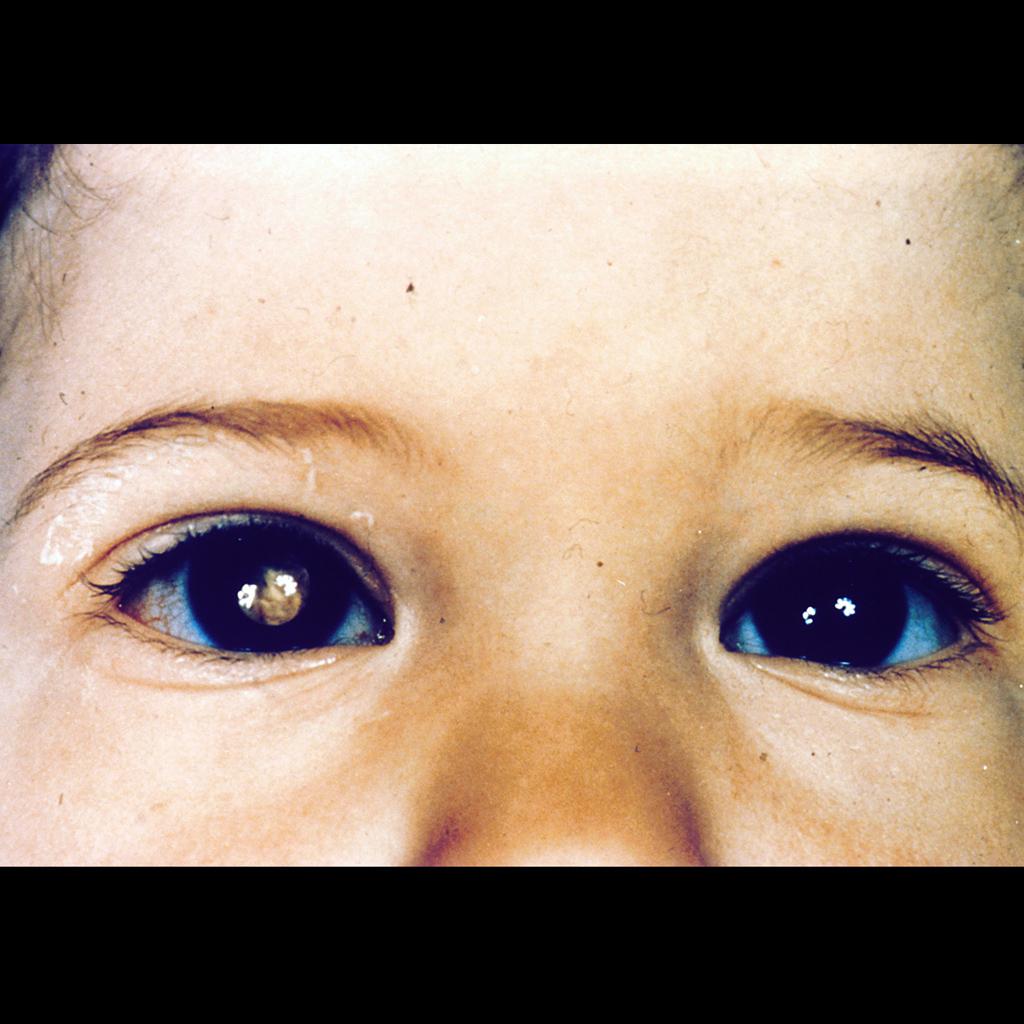Retinoblastoma history and symptoms: Difference between revisions
No edit summary |
No edit summary |
||
| Line 3: | Line 3: | ||
{{CMG}}{{AE}}{{Simrat}} | {{CMG}}{{AE}}{{Simrat}} | ||
==Overview== | ==Overview== | ||
The hallmark of retinoblastoma is [[leukocoria]] which is an abnormal appearance of the retina as viewed through the [[pupil]], also known as amaurotic cat's eye reflex.<ref name=" | The hallmark of retinoblastoma is [[leukocoria]] which is an abnormal appearance of the retina as viewed through the [[pupil]], also known as amaurotic cat's eye reflex. Other common symptoms include strabismus and proptosis. The clinical presentation depends on the stage of the disease. | ||
==History and ymptoms== | |||
Clinical features of retinoblatoma are approximately the same in variable studies and the common findings are as follow:<ref name="ChebbiBouguila2014">{{cite journal|last1=Chebbi|first1=A.|last2=Bouguila|first2=H.|last3=Boussaid|first3=S.|last4=Ben Aleya|first4=N.|last5=Zgholi|first5=H.|last6=Malek|first6=I.|last7=Zeghal|first7=I.|last8=Nacef|first8=L.|title=Le profil clinique du rétinoblastome en Tunisie|journal=Journal Français d'Ophtalmologie|volume=37|issue=6|year=2014|pages=442–448|issn=01815512|doi=10.1016/j.jfo.2014.01.009}}</ref><ref name="pmid14654593">{{cite journal |vauthors=Abramson DH, Beaverson K, Sangani P, Vora RA, Lee TC, Hochberg HM, Kirszrot J, Ranjithan M |title=Screening for retinoblastoma: presenting signs as prognosticators of patient and ocular survival |journal=Pediatrics |volume=112 |issue=6 Pt 1 |pages=1248–55 |date=December 2003 |pmid=14654593 |doi= |url=}}</ref><ref name="ShifaGezmu2017">{{cite journal|last1=Shifa|first1=Jemal Zeberga|last2=Gezmu|first2=Alemayehu Mekonnen|title=Presenting signs of retinoblastoma at a tertiary level teaching hospital in Ethiopia|journal=Pan African Medical Journal|volume=28|year=2017|issn=1937-8688|doi=10.11604/pamj.2017.28.66.11199}}</ref> | |||
*Leukocoria (an abnormal appearance of the [[retina]] as viewed through the [[pupil]], also known as amaurotic cat's eye reflex), (Please see below). | *Leukocoria (an abnormal appearance of the [[retina]] as viewed through the [[pupil]], also known as amaurotic cat's eye reflex), (Please see below). | ||
*Strabismus | *Strabismus (especially when the macula is involved) | ||
*Painful | *Decreased visual acquity | ||
*Painful red eye | |||
*Anterior scleral staphyloma | |||
*Hyphema | |||
*Buphthalmia | |||
*Loss of vision | *Loss of vision | ||
Presenting symptoms in adult onset of the tumor are insidious and are such as:<ref name="KhetanSengupta2016">{{cite journal|last1=Khetan|first1=Vikas|last2=Sengupta|first2=Sabyasachi|last3=Pan|first3=Utsab|title=Adult onset retinoblastoma|journal=Indian Journal of Ophthalmology|volume=64|issue=7|year=2016|pages=485|issn=0301-4738|doi=10.4103/0301-4738.190099}}</ref> | |||
*Dimness of vision | |||
*Perception of floater | |||
*Pain and redness | |||
[[File:Retinoblastoma leukocoria.jpeg |thumb|none|200px|T2 MRI showing retinoblastoma<ref name="radio1">Image courtesy of Dr. Frank Gaillard [http://www.radiopaedia.org Radiopaedia] (original file [http://radiopaedia.org/cases/retinoblastoma-leukocoria]).[http://radiopaedia.org/licence Creative Commons BY-SA-NC</ref>]] | [[File:Retinoblastoma leukocoria.jpeg |thumb|none|200px|T2 MRI showing retinoblastoma<ref name="radio1">Image courtesy of Dr. Frank Gaillard [http://www.radiopaedia.org Radiopaedia] (original file [http://radiopaedia.org/cases/retinoblastoma-leukocoria]).[http://radiopaedia.org/licence Creative Commons BY-SA-NC</ref>]] | ||
Advanced and/or metastatic form of the tumor also presents with constitutional symptoms such as: | |||
*Proptosis | |||
*Weight loss | |||
*Vomiting | |||
* | *Headache | ||
*Neurologic impairement | |||
*Orbital mass | |||
* | |||
* | |||
* | |||
* | |||
* | |||
==References== | ==References== | ||
Revision as of 17:32, 30 April 2019
|
Retinoblastoma Microchapters |
|
Diagnosis |
|---|
|
Treatment |
|
Case Studies |
|
Retinoblastoma history and symptoms On the Web |
|
American Roentgen Ray Society Images of Retinoblastoma history and symptoms |
|
Risk calculators and risk factors for Retinoblastoma history and symptoms |
Editor-In-Chief: C. Michael Gibson, M.S., M.D. [2]Associate Editor(s)-in-Chief: Simrat Sarai, M.D. [3]
Overview
The hallmark of retinoblastoma is leukocoria which is an abnormal appearance of the retina as viewed through the pupil, also known as amaurotic cat's eye reflex. Other common symptoms include strabismus and proptosis. The clinical presentation depends on the stage of the disease.
History and ymptoms
Clinical features of retinoblatoma are approximately the same in variable studies and the common findings are as follow:[1][2][3]
- Leukocoria (an abnormal appearance of the retina as viewed through the pupil, also known as amaurotic cat's eye reflex), (Please see below).
- Strabismus (especially when the macula is involved)
- Decreased visual acquity
- Painful red eye
- Anterior scleral staphyloma
- Hyphema
- Buphthalmia
- Loss of vision
Presenting symptoms in adult onset of the tumor are insidious and are such as:[4]
- Dimness of vision
- Perception of floater
- Pain and redness

Advanced and/or metastatic form of the tumor also presents with constitutional symptoms such as:
- Proptosis
- Weight loss
- Vomiting
- Headache
- Neurologic impairement
- Orbital mass
References
- ↑ Chebbi, A.; Bouguila, H.; Boussaid, S.; Ben Aleya, N.; Zgholi, H.; Malek, I.; Zeghal, I.; Nacef, L. (2014). "Le profil clinique du rétinoblastome en Tunisie". Journal Français d'Ophtalmologie. 37 (6): 442–448. doi:10.1016/j.jfo.2014.01.009. ISSN 0181-5512.
- ↑ Abramson DH, Beaverson K, Sangani P, Vora RA, Lee TC, Hochberg HM, Kirszrot J, Ranjithan M (December 2003). "Screening for retinoblastoma: presenting signs as prognosticators of patient and ocular survival". Pediatrics. 112 (6 Pt 1): 1248–55. PMID 14654593.
- ↑ Shifa, Jemal Zeberga; Gezmu, Alemayehu Mekonnen (2017). "Presenting signs of retinoblastoma at a tertiary level teaching hospital in Ethiopia". Pan African Medical Journal. 28. doi:10.11604/pamj.2017.28.66.11199. ISSN 1937-8688.
- ↑ Khetan, Vikas; Sengupta, Sabyasachi; Pan, Utsab (2016). "Adult onset retinoblastoma". Indian Journal of Ophthalmology. 64 (7): 485. doi:10.4103/0301-4738.190099. ISSN 0301-4738.
- ↑ Image courtesy of Dr. Frank Gaillard Radiopaedia (original file [1]).[http://radiopaedia.org/licence Creative Commons BY-SA-NC